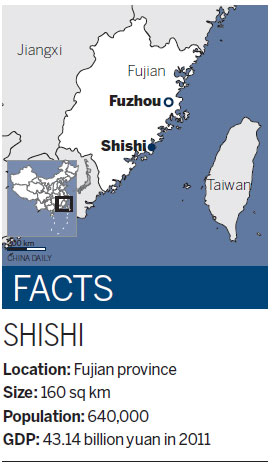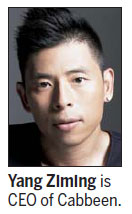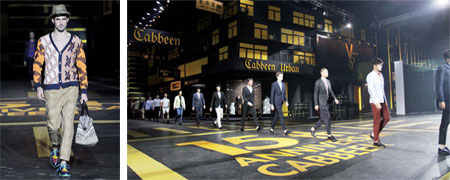The Milan Plan
Updated: 2013-01-25 08:55
By Lv Chang and Hu Meidong (China Daily)
|
||||||||
|
Left and right: Models parade during Cabbeen's Spring-Autumn Collection 2013 show in Beijing. Photos Provided to China Daily |

Textile city of shishi sets its sights on becoming an international fashion capital
The scene is familiar enough - an army of buyers, journalists, celebrities and VIPs line the runway and music blares as strutting models parade by, stitched up in their masters' latest creations. In this instance, it was Cabbeen's spring collection of menswear flouncing and glittering under the spotlights. It could have been Paris, London or New York, even Shanghai or Beijing. But, no, this was Shishi, a small coastal city in China's southern Fujian province. And Shishi wants to be Milan - or, rather, to be considered a fashion capital like Milan. As a major manufacturing hub for fashion apparel, Shishi has the credentials, with its experienced craftsmen and budding world-class designers. It also has a "Milan Plan" to take the city on that long journey upmarket.
Shishi doesn't aim just to be the place where big fashion houses like Armani, Zegna or Prada find the perfect jacket producer. Instead, the city wants to help local companies develop their domestic brands into international ones and become renowned labels in their own right.
"Many of our clothing brands are mainly low- and middle-end ones, and lack the power to develop high-end brands, so if we don't do this, we face the possibility of dropping out of the market eventually," says Tian Qiming, chairman of Shishi Textile and Garment Chamber of Commerce and also of Edenbo Group, a local menswear brand.
| ||||
Though Edenbo boasts of more than 3,000 stores nationwide, Tian says compared to foreign high-end brands, they still have a lot of catching up to do.
Like many other sectors in the economy, China's fashion industry suffers from a lack of innovation and original design. Many clothing companies have thousands of workers in factories and operating on razor-thin margins.
"The high-end market in the domestic fashion industry is still dominated by foreign brands, because they have very strong design teams, professional marketing experts and a long history of brand building," Tian says.
Falling export figures coupled with fierce competition within the local fashion industry are also pushing Shishi's clothing companies to upgrade on the global value chain.
"The Milan Plan" is to use the Chinese city's International Textile and Garment Center as a template to build a fashion capital like the Italian one.
With an investment of 4.35 billion yuan ($700 million, 524 million euros) and covering 188,000 square meters, the ITGC innovation industrial park of offices and design studios is expected to begin operating next year.
It aims to bring together designers, retailers, raw material suppliers, manufacturers and service providers, covering all sectors of the industry, in one location. This, it is hoped, will cut costs and improve original design and branding capabilities.
"Consolidation around a center is a clear path to victory, because joint efforts across all sectors will improve the effectiveness and allow for resource maximization," says the plan's creator, Xu Peiyuan, deputy director of the college of economics and finance at Huaqiao University.
Xu says they chose Milan as a model not just because it is the heart of fashion but also because the two cities have a lot in common.
"Both cities have a long history of manufacturing and benefit from a regional industry cluster," he says. "And more importantly, their family-owned businesses play a very important role."
Shishi is home to more than 1,000 textile and apparel companies, 90 percent of which are family-owned, and it is located in a golden triangle formed with Quanzhou and Xiamen Economic Zones, which accounts for more than 20 percent of China's textile and apparel production.
In Italy, with the silk city, Como, and a wool processing and textile center in Biella, Milan also forms a fashion industry triangle, accounting for more than 21 percent of the local economy.
"Like Milan, Shishi has some obvious advantages - the complete industrial chain, most skilled workers and the most advanced production equipment," says Zhang Qinghui, deputy secretary-general of China Fashion Week Organizing Committee and Chinese Clothing Designer Association. "But what makes one city a magnet for the fashion world is its original design and the ability to be flexible and understand changing tastes and trend."
This is where Shishi needs to improve, says Zhang, and it can learn from Milan, a city that has more than 1,000 mid-to-high end brands.

He sees the plan based on the International Textile and Garment Center as a way for young designers to showcase their work to clothing companies.
"The whole Milan project is not an abstract concept. It works out the ways in which Shishi can bridge the gap with the world's top fashion city," he says.
The fashion industry thrives on hype, but no one is under the illusion that bridging that gap and transforming the city's clothing producers into masters of design will be a smooth ride or reach glorified heights any time soon.
Liu Yiqun, designer and president of Wolf Zone, says domestic clothing brands have developed very fast and everything is new, but only a few will last because of the lack of long-term brand vision.
"In China many are imitating foreign brands, because the fashion industry here is pretty much in its infancy," says Liu, rated as one of China's top 10 fashion designers in 2012.
Chinese clothing brands struggle to penetrate the fast-growing domestic fashion market because they lack history as well as kudos, he says.
"Long tradition has been a mainstay for globally recognized luxury products. When you look at the logos of many foreign famous brands, they always begin with 'Since', which distinguishes it with a history and a story behind it."
Aside from playing a part in promoting their hometown's image, Shishi's few original designers, such as Liu and Yang Ziming, CEO of Cabbeen, an upscale men's clothing brand, are trying to attract more attention to their own styles by focusing on detail.
Yang, who is the first designer from China to hold a show at New York Fashion Week, says he put his own spin on style by adding unusual touches such as ornamental buttons and metal badges that wearers can mix and match as they please.
"Today, Chinese consumers are more fashion conscious, even men. They want something cutting-edge that can speak for who they are," says 41-year-old Yang.
For Shishi producers, for whom design is less of a priority, investing heavily in research and development, and trying to overcome distribution obstacles, are the main challenges on the road to brand success.
Lu Qi's brand is said to be leaving a lasting impression in the marketplace.
"We built up a very strong design team to expand our collections, focusing on the more fashion-conscious 20- to 40-year-old market segment," says Lu, the vice-president of Diking Group, one of China's leading men's wear manufacturers. "Our design concept conveys the soul of our brand - elegant, classic and simple."
Lu's company started selling in the domestic market under the Diking label in 2003, having realized its potential and the changing trends in fashion.
Before that, the company was an export-oriented manufacturer for the world's big fashion houses. Now domestic sales account for 65 percent and it competes successfully with foreign brands.
The switch to the home market forced Lu to employ professional designers and bring in an experienced team of marketing and branding consultants.
"The cost of doing one's own brand is very high," he says. "You need to hire fashion designers, participate in fashion shows and organize marketing campaigns.
"The cost of hiring a top-level chief designer alone will be around 5 million yuan."
Contact the writers at lvchang@chinadaily.com.cn and humeidong@chinadaily.com.cn
(China Daily 01/25/2013 page12)

 Li Na on Time cover, makes influential 100 list
Li Na on Time cover, makes influential 100 list
 FBI releases photos of 2 Boston bombings suspects
FBI releases photos of 2 Boston bombings suspects
 World's wackiest hairstyles
World's wackiest hairstyles
 Sandstorms strike Northwest China
Sandstorms strike Northwest China
 Never-seen photos of Madonna on display
Never-seen photos of Madonna on display
 H7N9 outbreak linked to waterfowl migration
H7N9 outbreak linked to waterfowl migration
 Dozens feared dead in Texas plant blast
Dozens feared dead in Texas plant blast
 Venezuelan court rules out manual votes counting
Venezuelan court rules out manual votes counting
Most Viewed
Editor's Picks

|

|

|

|

|

|
Today's Top News
Boston bombing suspect reported cornered on boat
7.0-magnitude quake hits Sichuan
Cross-talk artist helps to spread the word
'Green' awareness levels drop in Beijing
Palace Museum spruces up
First couple on Time's list of most influential
H7N9 flu transmission studied
Trading channels 'need to broaden'
US Weekly

|

|











